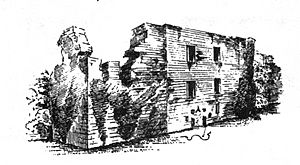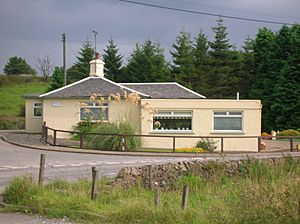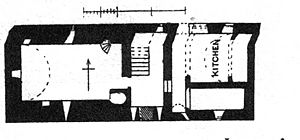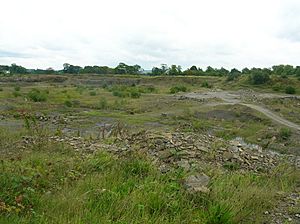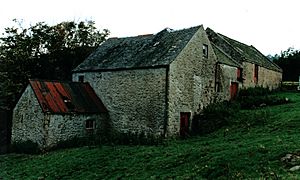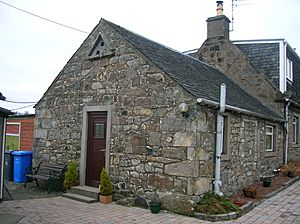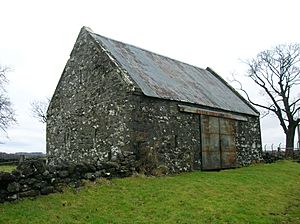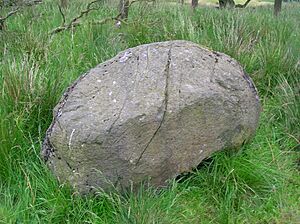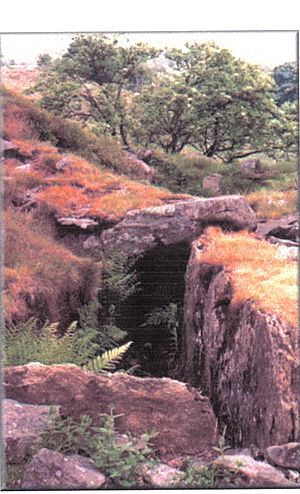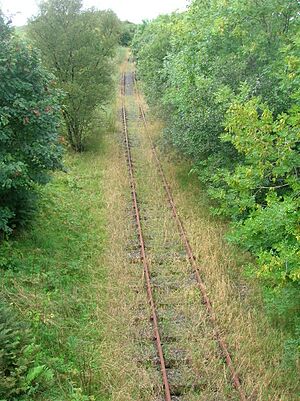Hessilhead facts for kids
Hessilhead is a place in Beith, North Ayrshire, Scotland. It was once known as Hazlehead or Hasslehead. The land was part of the larger area called the Lordship of Giffen and the Barony of Hessilhead, located in the Cunninghame region and the Parish of Beith.
Contents
Hessilhead Castle: A Look Back
In the late 1800s, people described Hessilhead Castle as a building without a roof and falling apart. It was a long building, about 22.5 meters (74 feet) long and 11.7 meters (38.5 feet) wide. It was built in two main parts. The older western part was likely a strong tower from the 1400s to 1600s. The eastern part was added by Francis Montgomerie, who bought the land in 1680. Both parts had arched ceilings on the ground floor. The upper parts were too damaged to describe properly. The castle started to fall apart around 1776. An old mapmaker named Timothy Pont noted that it was a strong, old building surrounded by big ditches and located near a loch (a lake).
In 1949, a newspaper article showed photos of the castle ruins covered in ivy, set in a garden with paths. However, by 1956, official records said Hessilhead Castle had been completely torn down. They also said that stone quarrying nearby had removed any signs of a moat (a ditch around the castle). This wasn't entirely true, as some rubble and foundations can still be seen today. Also, the water from the quarry still drains into what was once the moat. The loch that Pont mentioned has since been drained, and the ditches filled in.
Old maps show the area changing over time. William Roy's map from 1747-1755 shows a farm town called Hazlehead and the castle of Heeselhead (another spelling) surrounded by trees. Later maps in 1775 and 1832 also show the farm town and the castle ruins.
In its later years, the family of Lord Glasgow lived at Hessilhead. After they left, a Mr. Macmichael, who owned the property, removed the roof around 1776, letting the castle fall into ruin. Another person, Mr. Carmichael, is said to have sold parts of the castle and even an old Yew tree. In the 1960s, the remaining parts of the castle were blown up.
Francis Montgomerie had added a large, more modern part to the old square castle. He also planted many trees in the shape of a cross, which was a popular style back then. It's thought that Coldstream Mill was built around this time.
A local historian, Dobie, wrote that near the ruined castle, there was a special echo that would slowly repeat voices, adding a sad feeling to the place.
The Story of Hessilhead Lands
The first person recorded to own the lands of Hessilhead was Hugh de Eglintoun. His family line continued until Elizabeth de Eglintoun, the only heir, married Sir John de Montgomerie of Eaglesham. Elizabeth's mother was related to King Robert II of Scotland. When Hugh Eglintoun, Elizabeth's father, died around 1378, the Montgomerie family inherited the lands. From then on, Hessilhead's history is closely tied to the Montgomerie family.
Many Montgomeries owned Hessilhead over the years. Sir John Montgomerie of Hessilhead died in a battle in 1513. His son Hugh inherited the estate, and then Hugh's son John took over. This John helped look after the young Earl of Eglintoun. John's son, also named Hugh, was part of a special parliament in 1560 that set up the Protestant faith in Scotland.
Later, Robert Montgomerie sold Hessilhead to Francis Montgomerie, the second son of the seventh Earl of Eglinton. Francis also owned Giffen Castle and had an exciting life. He was a powerful figure in the government during the reigns of King William III and Queen Anne. In 1706, he was one of the people chosen to work on the Treaty of Union, which joined Scotland and England.
The Act of Union was not popular with everyone. Some songs from 1706 made fun of the people who supported it, including Francis Montgomerie.
Francis added a new part to the old castle and put a slate roof on it, making it one of the nicest homes in the area. He also planted many trees in straight lines and at right angles, a popular style from the Netherlands. Even in the 1860s, much of this planned landscape still existed.
In 1697, Francis was one of the people who looked into cases of witchcraft. In one famous case, five people were burned at the stake. In 1692, the name of the place was spelled Hyslehead.
Francis's son, John, got into so much debt that Hessilhead had to be sold in 1722. It was bought by Colonel Patrick Ogilvie, who later sold it to Robert Brodie. In 1768, Michael Carmichael bought it.
The Montgomerie family of Hessilhead had a special coat of arms. It showed two lances, three golden lily-like flowers, and a golden ring.
The old church in Beith had a special area called the Hessilhead loft in the East Wing. This loft and the carved wooden Montgomerie coat of arms were moved when the new church was built.
Old maps show that Hessilhead Cottage was next to a well-kept walled garden, but by 1897, the garden was ruined. A gamekeeper's cottage and a place for pheasants are marked from 1912, when a curling pond also appeared near the castle ruins. In 1827, a lime works (a place to process limestone) was shown on the map in the castle grounds.
Trearne Estate and Its Owners
In 1807, Dr. Robert Patrick of Trearne bought the Hessilhead estate. He was an army doctor. Later, the estate passed to other members of the Patrick family.
James Dunlop, a famous astronomer, lived at Trearne Lodge in 1820. He became the Astronomer Royal for New South Wales, Australia, and achieved many awards for his work.
Trearne House was built around 1870, on the spot of an older house. During World War II, Trearne House was used by the army. After the war, it became a boarding school for boys whose parents worked abroad.
Limestone Quarries: Changing the Landscape
The area has many old limestone quarries, both small and large. These quarries have unfortunately destroyed many of the old estate features. Trearne House and an ancient chapel and well dedicated to Saint Bridget also disappeared due to quarrying. A flooded quarry near the old castle is now used by the Hessilhead Wildlife Rescue Centre to help swans and other water birds recover.
The Templelands of Cunninghame
The Knights Templar, a famous medieval order, once owned a lot of land in the Cunninghame area. In the early 1600s, Robert Montgomerie gained the rights to these "Templelands." This meant he was the feudal superior, which gave him special rights and tax benefits. Later, these lands were bought by Dr. Robert Patrick of Trearne and Hessilhead.
Coldstream Mill: A Working Water Mill
Coldstream Mill was built to serve the Hessilhead area. It was also known as Whitestone Mill. It was first mentioned in 1728, but it might have been built earlier, around 1673, as part of the improvements made by Francis Montgomerie, who made the castle one of the best houses around.
The mill changed hands many times over the centuries, with different families owning and operating it. The Caldwell family owned it for about 100 years. In 1921, the Smith family bought the mill, and Joseph Smith's son, Andrew, worked it until 1991.
Coldstream Mill was used to prepare animal feed, grinding things like linseed cake, beans, corn, and barley. It had three sets of grinding stones. The mill never needed electricity because it was powered by a waterwheel from a mill pond. It was the last traditional working water mill in Ayrshire and one of the last in Scotland. Some items from the mill are now on display at the Dalgarven Mill museum. The mill building has since been turned into a private house, but the waterwheel and mill pond have been kept.
The Farm Town of Hessilhead
The 1858 OS map shows a small village with a school, a house called Damback, a sawmill, and a mill dam. This village might have been called Nethertoun or 'Haselet' (from 'Hasslehead Hamlet'). The school closed by 1897. A small Hessilhead 'Farm Town' still exists today, dating back to at least the 1740s. It's a rare example of a typical 18th-century farm town.
Matthew Pollock, who started a furniture business in Beith, went to school here. After the school closed, he used its bell at his factory to signal the start and end of the workday. The school was originally a single-story building with a thatched roof. In 1844, a second story was added, and it was given a slate roof.
These "Farm Towns" came from how land was divided in medieval times. A "ploughgate" was about 104 acres, the amount of land one team of oxen could farm in a year. This led to small farm towns like Hessilhead, with homes for several people.
Duskwater Cottage was where the blacksmith worked, and a cobbler (shoe repairer) also had a shop there. A well, 9 meters (30 feet) deep, still survives, covered by a sandstone slab with a hole for a hand pump.
Hessilhead Mill has been torn down, but parts of the circular grain kiln remain, attached to the ruins of the miller's house. You can still see the path of the lade (a channel that carried water to the mill) and the sluice (a gate to control water flow). Steps once led down to the waterwheel, which was buried in place.
A working water pump from the Victorian era still stands next to the Dusk water in the village. This pump was powered by a small waterwheel.
Balgray: Old Farm Buildings
The Balgray lands were once part of the Hessilhead estate, owned by the Montgomeries in the 1500s. Today, only a cottage and a barn remain from what was once a larger group of farm buildings. The barn, built in 1797, likely had a thatched or slate roof. It probably used to be a cart shed. The small wing of the 1767 cottage might have been used for storage or for cattle. The surviving doocot (pigeon house) shows that pigeons were kept in the loft for food.
Crookhill: A Name with History
Crookhill is a changed version of 'Crosshill'. Its name refers to a cross that was put up nearby to mark the edge of the lands owned by the old Chapel of Saint Bridget.
The Ghostly Knight and the Bride
This is an old legend about Henry Montgomerie of Hessilhead and Anna Cunninghame of Aiket Castle. They were in love and planned to marry when Henry returned from the crusades. However, a man named Allan Lockhart wanted to marry Anna. He tricked a soldier returning from the Crusades into saying that Henry Montgomerie had died. Anna believed the story, and a wedding day was set for her and Allan.
On the wedding day, Henry returned to Hessilhead Castle and found out about the trick. He rushed to claim his bride but fell from his horse and died. At midnight during the wedding feast, a knight in full armor, said to be Henry, walked into Aiket Castle hall, picked up Lady Anna, and disappeared into the night. Neither the knight nor the bride were ever seen again.
|
Alexander Montgomerie: The Poet
Alexander Montgomerie was a poet from the 1500s. He was a younger son of Hugh Montgomerie of Hessilhead and was related to both the Earl of Eglinton and King James VI. We don't know much about his early life, but he was raised as a Protestant. He later traveled to Europe and became Catholic in Spain. He might have served in the Scottish army in the Netherlands. He died sometime between 1607 and 1611.
His poems covered many topics, from elegant court songs to witty pieces for the king, and even deep religious poems. Montgomerie is considered one of the best Scottish poets of his time, especially known for his sonnets. The famous poet Robert Burns was inspired by Alexander Montgomerie's style.
One of his most famous works is The Cherrie and the Slae, a long religious story that was probably meant to be sung. The title might refer to the cherry as a symbol of good and the sloe (a bitter fruit) as a symbol of bad. Alexander was one of the last court poets to write in the Scots language.
It was said that Alexander's son, also named Alexander, and his cousin, Mrs. Vallange, were bewitched. The case went to trial because of their "trouble and sickness," but the court's decision isn't known.
Archbishop Robert Montgomerie
In the 1580s, Robert Montgomerie of Hessilhead was made the Archbishop of Glasgow in 1581. However, he was forced to give up this position in 1587. This was a "tulchan" post, meaning that the person who appointed him got the money from the job, while Robert wasn't expected to do many of the duties. Robert died around 1609. He was the brother of the poet Alexander.
Archaeology: Clues from the Past
The Cuff Hill rocking stone is a very large boulder that sits on another type of rock. Some people think it was used by the Druids, an ancient Celtic religious group. It used to rock, but it no longer does because people dug underneath it. It is in a small wood and surrounded by a circular stone wall.
A crack in the side of Cuff Hill is called 'St. Inan's Chair' and is said to have been used by a saint as a pulpit (a raised platform for speaking). A clear holy well was also nearby, but it is now covered. On Cuff Hill, there were also four standing stones called the 'Druids' Graves', found again in 1813.
A chapel and well dedicated to St. Bridget once existed at nearby Trearne on a small hill. It had a burial ground and a carving of two figures that looked like a cat and a rabbit. The ruins at Trearne were destroyed by quarrying not long ago.
Railways: Connecting Hessilhead
Hessilhead never had its own railway station. However, several train lines ran close by. One line went from Lugton to Beith. The station in Beith opened in 1873 and was later renamed Beith Town. It closed to passengers in 1962, but freight services continued until 1964.
The railway line to Beith still exists in some parts. In 2000, a large emergency exercise was held on the line near Lugton. It simulated a train crash with 270 passengers to test how emergency services would respond. This helped make sure Scotland's train passengers are safe.
Hessilhead Wildlife Rescue Centre
Hessilhead is home to a wildlife rescue centre run by Andy and Gay Christie for over 20 years. They help injured and abandoned animals and birds, treating more than 3,000 creatures every year. They have a special room for treating swans and use a nearby flooded limestone quarry for swans and other water birds to recover. The centre has X-ray machines and a surgery room, and a veterinarian works there part-time. They also hold an annual open day for visitors.
See also
- Barony of Ladyland
- Blae Loch, Beith - part of the old estate.
- Eglinton Country Park The Eglintouns of Hessilhead.
- Silverwood, Ayrshire Robert Montgomerie of Silverwood and Hessilhead



